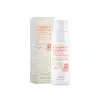What's inside
What's inside
 Key Ingredients
Key Ingredients

 Benefits
Benefits

 Concerns
Concerns

No concerns
 Ingredients Side-by-side
Ingredients Side-by-side

Sodium Cocoyl Isethionate
CleansingSodium Lauroyl Glutamate
Coconut Acid
CleansingSodium Isethionate
CleansingWater
Skin ConditioningSodium Bicarbonate
AbrasiveZea Mays Starch
AbsorbentCalamine
AbsorbentHouttuynia Cordata Extract
Skin ConditioningLaminaria Japonica Extract
Skin ProtectingCentella Asiatica Extract
CleansingSodium Polyacrylate
AbsorbentSucrose
HumectantAscorbic Acid
AntioxidantSodium Hyaluronate
HumectantCentella Asiatica Leaf/Stem Powder
Protease
ExfoliatingBromelain
Skin ConditioningSea Salt
AbrasiveGlycerin
HumectantHydrogenated Phosphatidylcholine
Emulsifying1,2-Hexanediol
Skin ConditioningCaprylic/Capric Triglyceride
MaskingButylene Glycol
HumectantAsiaticoside
AntioxidantMadecassic Acid
Skin ConditioningAsiatic Acid
Skin ConditioningMadecassoside
AntioxidantSucrose Stearate
EmollientCetearyl Alcohol
EmollientSodium Cocoyl Isethionate, Sodium Lauroyl Glutamate, Coconut Acid, Sodium Isethionate, Water, Sodium Bicarbonate, Zea Mays Starch, Calamine, Houttuynia Cordata Extract, Laminaria Japonica Extract, Centella Asiatica Extract, Sodium Polyacrylate, Sucrose, Ascorbic Acid, Sodium Hyaluronate, Centella Asiatica Leaf/Stem Powder, Protease, Bromelain, Sea Salt, Glycerin, Hydrogenated Phosphatidylcholine, 1,2-Hexanediol, Caprylic/Capric Triglyceride, Butylene Glycol, Asiaticoside, Madecassic Acid, Asiatic Acid, Madecassoside, Sucrose Stearate, Cetearyl Alcohol
Sodium Bicarbonate
AbrasiveSodium Lauroyl Glutamate
Zea Mays Starch
AbsorbentSodium Cocoyl Isethionate
CleansingCoconut Acid
CleansingCamellia Sinensis Leaf Powder
ExfoliatingWater
Skin ConditioningSodium Isethionate
CleansingPapain
Skin ConditioningZinc Oxide
Cosmetic ColorantLysine Hcl
Skin ConditioningSodium Ascorbyl Phosphate
AntioxidantAcetyl Methionine
Skin ConditioningTheanine
EmollientProline
Skin ConditioningBetaine
HumectantCellulose Gum
Emulsion StabilisingCitric Acid
BufferingCarica Papaya Fruit Extract
Skin ConditioningSorbitol
HumectantGlycerin
HumectantButylene Glycol
Humectant1,2-Hexanediol
Skin ConditioningSodium Hyaluronate
HumectantSodium Bicarbonate, Sodium Lauroyl Glutamate, Zea Mays Starch, Sodium Cocoyl Isethionate, Coconut Acid, Camellia Sinensis Leaf Powder, Water, Sodium Isethionate, Papain, Zinc Oxide, Lysine Hcl, Sodium Ascorbyl Phosphate, Acetyl Methionine, Theanine, Proline, Betaine, Cellulose Gum, Citric Acid, Carica Papaya Fruit Extract, Sorbitol, Glycerin, Butylene Glycol, 1,2-Hexanediol, Sodium Hyaluronate
 Reviews
Reviews

Ingredients Explained
These ingredients are found in both products.
Ingredients higher up in an ingredient list are typically present in a larger amount.
1,2-Hexanediol is a synthetic liquid and another multi-functional powerhouse.
It is a:
- Humectant, drawing moisture into the skin
- Emollient, helping to soften skin
- Solvent, dispersing and stabilizing formulas
- Preservative booster, enhancing the antimicrobial activity of other preservatives
Butylene Glycol (or BG) is used within cosmetic products for a few different reasons:
Overall, Butylene Glycol is a safe and well-rounded ingredient that works well with other ingredients.
Though this ingredient works well with most skin types, some people with sensitive skin may experience a reaction such as allergic rashes, closed comedones, or itchiness.
Learn more about Butylene GlycolCoconut Acid isn't fungal acne safe.
Glycerin is already naturally found in your skin. It helps moisturize and protect your skin.
A study from 2016 found glycerin to be more effective as a humectant than AHAs and hyaluronic acid.
As a humectant, it helps the skin stay hydrated by pulling moisture to your skin. The low molecular weight of glycerin allows it to pull moisture into the deeper layers of your skin.
Hydrated skin improves your skin barrier; Your skin barrier helps protect against irritants and bacteria.
Glycerin has also been found to have antimicrobial and antiviral properties. Due to these properties, glycerin is often used in wound and burn treatments.
In cosmetics, glycerin is usually derived from plants such as soybean or palm. However, it can also be sourced from animals, such as tallow or animal fat.
This ingredient is organic, colorless, odorless, and non-toxic.
Glycerin is the name for this ingredient in American English. British English uses Glycerol/Glycerine.
Learn more about GlycerinSodium Bicarbonate has a more famous name: Baking soda.
In cosmetics, it is used to adjust the acidity. Due to its white crystalline solid form, it can also be an abrasive (exfoliator).
This ingredient is water-soluble.
Learn more about Sodium BicarbonateSodium cocoyl isethionate is a natural ingredient from coconut oil. It is an ultra gentle cleanser that gives a nice foam without drying the skin or impacting the skin barrier.
The amount of foam created depends on the amount of sodium cocoyl isethionate used in the product.
This ingredient also helps improve the spreadability of a product.
Learn more about Sodium Cocoyl IsethionateSodium Hyaluronate is hyaluronic acid's salt form. It is commonly derived from the sodium salt of hyaluronic acid.
Like hyaluronic acid, it is great at holding water and acts as a humectant. This makes it a great skin hydrating ingredient.
Sodium Hyaluronate is naturally occurring in our bodies and is mostly found in eye fluid and joints.
These are some other common types of Hyaluronic Acid:
Learn more about Sodium HyaluronateWe don't have a description for Sodium Isethionate yet.
Sodium Lauroyl Glutamate is the sodium salt from the lauric acid of glutamic acid.
It is a surfactant and helps cleanse the skin. Surfactants gather oil, dirt, and other pollutants from your skin so they may be washed away easily.
Water. It's the most common cosmetic ingredient of all. You'll usually see it at the top of ingredient lists, meaning that it makes up the largest part of the product.
So why is it so popular? Water most often acts as a solvent - this means that it helps dissolve other ingredients into the formulation.
You'll also recognize water as that liquid we all need to stay alive. If you see this, drink a glass of water. Stay hydrated!
Learn more about WaterZea Mays Starch is starch made from corn. You might know this as cornstarch . It is used to thicken a product. It can replace talc as an absorbent.
The pH of cornstarch is 5.92.
Cornstarch is a common food ingredient used to thicken soups or to make corn syrup.
Learn more about Zea Mays Starch